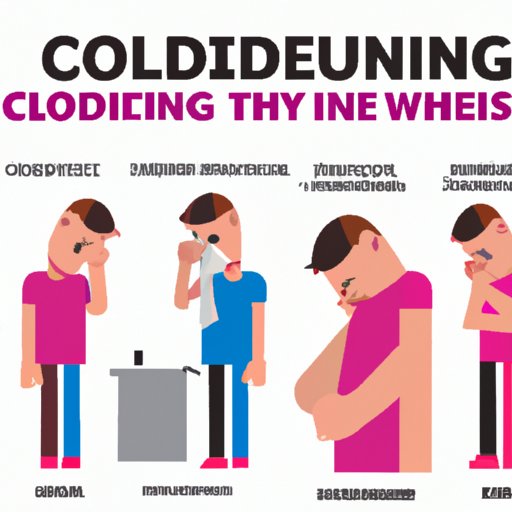Introduction
A cold is an infection caused by a virus. It’s typically characterized by symptoms such as a runny nose, sneezing, coughing, congestion, and a sore throat. Colds are highly contagious, and it’s important to know when you’re contagious so that you can take steps to prevent spreading it to others. In this article, we will explore when you’re most likely to be contagious with a cold and provide tips for reducing your risk of contagion.
Identifying the Symptoms of a Cold and When You’re Contagious
The common symptoms of a cold usually appear within one to three days after being exposed to the virus. These symptoms can include a runny or stuffy nose, sneezing, fatigue, a sore throat, coughing, and body aches. According to the Centers for Disease Control and Prevention (CDC), you are most contagious when you first develop symptoms and can remain contagious until all of your symptoms have gone away.
How to Avoid Spreading Your Cold to Others
There are several ways to help reduce the risk of spreading your cold to other people. The CDC recommends practicing good hygiene, such as washing your hands frequently with soap and water for at least 20 seconds. You should also stay home from work or school if you’re feeling sick, and wear a mask if you need to leave the house. Additionally, it’s important to cover your mouth and nose when you cough or sneeze, and throw away used tissues immediately.

The Role of Viral Shedding in Cold Contagion
Viral shedding is the process of a virus being released from the body and potentially infecting another person. According to a study published in the journal Clinical Infectious Diseases, the highest levels of viral shedding occur during the first three days of illness. This means that you are most likely to spread the virus during this time period.
Understanding the Difference between a Cold and the Flu
It’s important to understand the difference between a cold and the flu so that you can determine when you’re contagious and how to treat it. The flu is a more serious respiratory illness than a cold and is caused by the influenza virus. Common symptoms of the flu include fever, chills, body aches, and fatigue. The flu usually lasts for about one to two weeks, whereas a cold typically only lasts for about seven to 10 days.
Treatment for the flu includes rest, fluids, and over-the-counter medications to help relieve symptoms. In some cases, your doctor may prescribe antiviral medications to reduce the severity and duration of the illness. However, there is no specific treatment for a cold, and it is generally recommended to get plenty of rest and drink lots of fluids to help reduce symptoms.

Common Mistakes People Make When Trying to Prevent Contagion
When trying to prevent the spread of a cold, it’s important to avoid certain mistakes. For example, not washing your hands properly can increase the risk of spreading the virus. Additionally, not practicing social distancing and not disinfecting surfaces can also increase the risk of contagion. It’s important to follow the recommended guidelines to help reduce the risk of spreading your cold.
How Long Does It Take to Become Non-Contagious?
It typically takes about seven to 10 days for cold symptoms to go away, according to the Mayo Clinic. However, some people may still be contagious for up to two weeks after their symptoms have disappeared. Other factors, such as age, underlying health conditions, and the severity of the infection can also affect how long you remain contagious.

Tips for Reducing Cold Contagion Risk
There are several steps you can take to help reduce your risk of catching or spreading a cold. First, getting vaccinated for the flu and other illnesses can help protect you from becoming infected. Additionally, eating a healthy diet, getting enough sleep, and avoiding contact with people who are sick can also reduce your risk of contagion.
Conclusion
Colds are highly contagious, and it’s important to understand when you’re most likely to be contagious so that you can take steps to prevent spreading it to others. Common symptoms of a cold include a runny or stuffy nose, sneezing, coughing, and a sore throat. You are most contagious when you first develop symptoms and can remain contagious until all of your symptoms have gone away. To help reduce your risk of catching or spreading a cold, practice good hygiene, stay home from work or school if you’re feeling sick, and get vaccinated for the flu and other illnesses.
By knowing the signs and taking preventive measures, you can help reduce the risk of spreading your cold to other people. Taking these steps can help keep yourself and those around you healthy and safe.
(Note: Is this article not meeting your expectations? Do you have knowledge or insights to share? Unlock new opportunities and expand your reach by joining our authors team. Click Registration to join us and share your expertise with our readers.)
